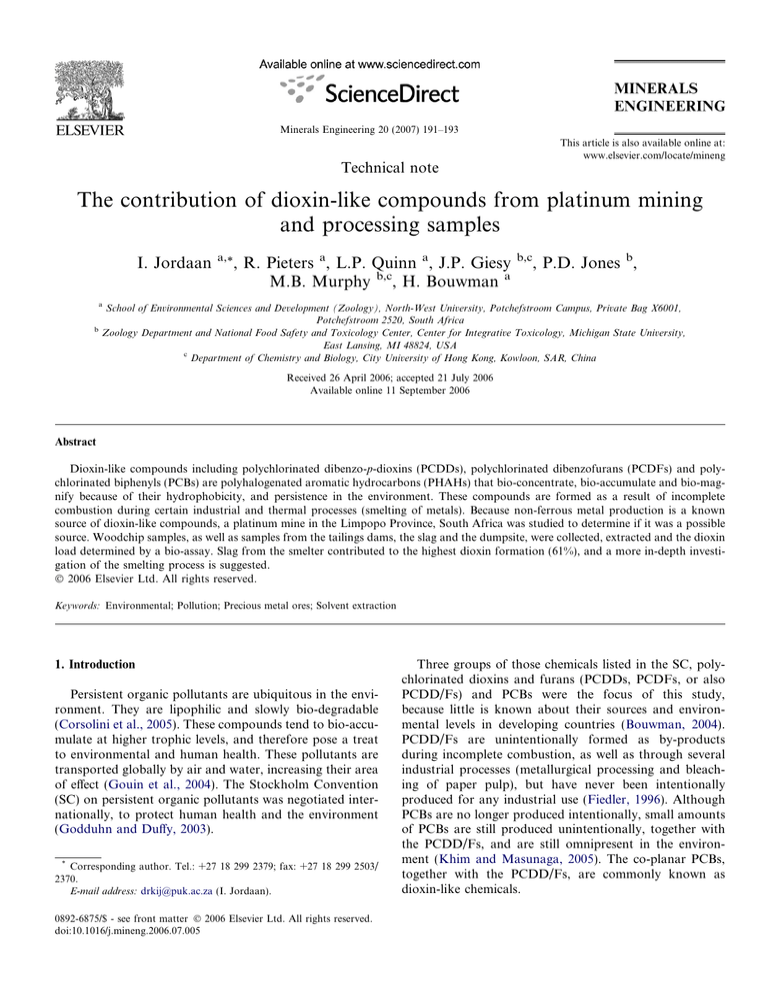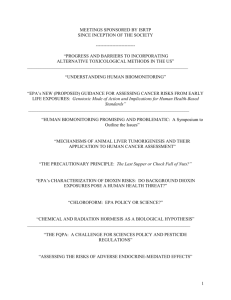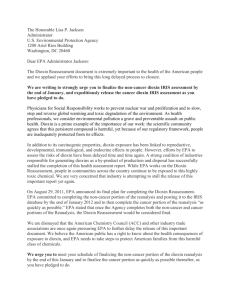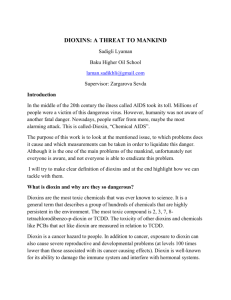The contribution of dioxin-like compounds from platinum mining and processing samples
advertisement

Minerals Engineering 20 (2007) 191–193 This article is also available online at: www.elsevier.com/locate/mineng Technical note The contribution of dioxin-like compounds from platinum mining and processing samples I. Jordaan a,* , R. Pieters a, L.P. Quinn a, J.P. Giesy M.B. Murphy b,c, H. Bouwman a b,c , P.D. Jones b, a b School of Environmental Sciences and Development (Zoology), North-West University, Potchefstroom Campus, Private Bag X6001, Potchefstroom 2520, South Africa Zoology Department and National Food Safety and Toxicology Center, Center for Integrative Toxicology, Michigan State University, East Lansing, MI 48824, USA c Department of Chemistry and Biology, City University of Hong Kong, Kowloon, SAR, China Received 26 April 2006; accepted 21 July 2006 Available online 11 September 2006 Abstract Dioxin-like compounds including polychlorinated dibenzo-p-dioxins (PCDDs), polychlorinated dibenzofurans (PCDFs) and polychlorinated biphenyls (PCBs) are polyhalogenated aromatic hydrocarbons (PHAHs) that bio-concentrate, bio-accumulate and bio-magnify because of their hydrophobicity, and persistence in the environment. These compounds are formed as a result of incomplete combustion during certain industrial and thermal processes (smelting of metals). Because non-ferrous metal production is a known source of dioxin-like compounds, a platinum mine in the Limpopo Province, South Africa was studied to determine if it was a possible source. Woodchip samples, as well as samples from the tailings dams, the slag and the dumpsite, were collected, extracted and the dioxin load determined by a bio-assay. Slag from the smelter contributed to the highest dioxin formation (61%), and a more in-depth investigation of the smelting process is suggested. 2006 Elsevier Ltd. All rights reserved. Keywords: Environmental; Pollution; Precious metal ores; Solvent extraction 1. Introduction Persistent organic pollutants are ubiquitous in the environment. They are lipophilic and slowly bio-degradable (Corsolini et al., 2005). These compounds tend to bio-accumulate at higher trophic levels, and therefore pose a treat to environmental and human health. These pollutants are transported globally by air and water, increasing their area of effect (Gouin et al., 2004). The Stockholm Convention (SC) on persistent organic pollutants was negotiated internationally, to protect human health and the environment (Godduhn and Duffy, 2003). * Corresponding author. Tel.: +27 18 299 2379; fax: +27 18 299 2503/ 2370. E-mail address: drkij@puk.ac.za (I. Jordaan). 0892-6875/$ - see front matter 2006 Elsevier Ltd. All rights reserved. doi:10.1016/j.mineng.2006.07.005 Three groups of those chemicals listed in the SC, polychlorinated dioxins and furans (PCDDs, PCDFs, or also PCDD/Fs) and PCBs were the focus of this study, because little is known about their sources and environmental levels in developing countries (Bouwman, 2004). PCDD/Fs are unintentionally formed as by-products during incomplete combustion, as well as through several industrial processes (metallurgical processing and bleaching of paper pulp), but have never been intentionally produced for any industrial use (Fiedler, 1996). Although PCBs are no longer produced intentionally, small amounts of PCBs are still produced unintentionally, together with the PCDD/Fs, and are still omnipresent in the environment (Khim and Masunaga, 2005). The co-planar PCBs, together with the PCDD/Fs, are commonly known as dioxin-like chemicals. 192 I. Jordaan et al. / Minerals Engineering 20 (2007) 191–193 Non-ferrous metal production in general is a known source of dioxin-like chemicals (UNEP, 2003). Oxygen, chlorine, and carbon in the presence of catalysts and at high temperatures are necessary for the formation of these compounds (Stanmore, 2004). Because thermal processes (such as explosions and smelting) are part of the mining and processing of platinum, platinum mining could be a possible source of dioxin-like chemicals, and therefore this study. 2. Experimental details 7% 8% Woodchips Tailing dams 24% Dumpsite 61% Slag 2.1. Sampling and extraction Environmental and process samples (tailing dams, dumpsite material, woodchips and slag) were collected from a platinum mine complex in the Limpopo Province, South Africa. Composite samples were collected with precleaned equipment as described in US EPA method 1613 (1994a). The samples were stored at 4 C, prior to analysis. The samples were freeze-dried and homogenised (0.5 mm mesh) and extracted with high-grade hexane, by Soxhlet extraction (US EPA, 1996a). The samples were concentrated (US EPA, 1999), and treated with sulphuric acid to eliminate interferences (US EPA, 1996b). Extracts were concentrated further, and stored at 4 C (US EPA, 1994b). A dilution series was prepared from each extract for the bio-assay. 2.2. The H4IIE reporter gene bio-assay Dioxin isomers are quantified by expensive gas chromatography and mass spectrometry techniques, but can also be semi-quantified using a genetically-modified cell line (bio-assay) (Van Overmeire et al., 2001). The H4IIE-luc reporter gene bio-assay gives an integrative measure of the toxicity of all dioxin congeners present in the various matrices. This integrative measure is called the toxic equivalency quotient (TEQ). The TEQ expresses the toxic effects of all dioxins in relation to the most toxic congener 2,3,7,8-tetrachlorodibenzo-para-dioxin (TCDD) present in the mixture (Giesy et al., 2002). H4IIE-luc cells were developed at Michigan State University by stably transfecting H4IIE rat hepatoma cells with the gene that produces luciferase in fireflies (El-Fouly et al., 1994). This gene is expressed in the presence of the pollutant. When the substrate of the luciferase is added, light is emitted, and detected with a luminometer. Concentrations of TEQ were calculated for each sample based on the light production by comparing the luciferase activity caused by the extract, to that of TCDD standards (Schramm et al., 2001). 3. Results and discussion The woodchips contributed the smallest amount of TEQ (5.4 ng TEQ/kg, dw; 7%; Fig. 1). Although dioxins would Fig. 1. The percentage contribution of the platinum mining and processing samples to the dioxin load of the total environment. adhere to organic carbon (Lodge, 2002), the woodchips formed during extractive explosions contained little TEQ. However, it is also possible that some of the dioxin-like compounds might have been photolysed because of exposure to UV radiation (sun light), once removed and stored on the surface. The TEQ contribution at the tailing dams was 8% (6.3 ng TEQ/kg, dw; Fig. 1). Because of the organic fraction in tailing dams (Maboeta and Van Rensburg, 2003), greater concentrations of TEQ would be expected. The dioxin contribution at the dumpsite was 24% (1.8 · 101 ng TEQ/kg, dw; Fig. 1). The sample was a mixture of soil, woodchips and plastics. The mine is not the only contributor to the dumping site and other anthropogenic activities such as waste burning activities, non-effective waste handling and disposal (Roots et al., 2004) might add to the dioxin load. The slag contributed 61% (4.5 · 101 ng TEQ/kg, dw; Fig. 1) of the TEQ. This is contradictory to expectations because slag is tapped at above 1000 C, a temperature high enough to prevent formation of dioxins (Stanmore, 2004). The reason for this is unknown, but a de novo synthesis (Huang and Buekens, 1996) during cooling might be possible. As far as we could establish, no chlorine-containing chemicals were added, but trace amounts would have been enough to play a part in the formation of dioxins. Certain reduction measures could be implemented at the smelter to reduce the formation of dioxin-like chemicals as described in the ‘‘Guidelines on best available techniques and provisional guidance on best environmental practices’’ (Anon, 2005). In managing the various processes more effectively regarding dioxin formation (combustion or high temperature processes), the risks posed to environmental and human health would consequently be minimised. In future, measurement of TEQ could be used to assess the effectiveness of any mitigation measures implemented to reduce the formation of dioxin-like chemicals of the activities associated with platinum mining and processing. I. Jordaan et al. / Minerals Engineering 20 (2007) 191–193 4. Conclusion Dioxins were found to be formed during the process of mining and processing platinum, but, the rate of formation, for the processes we studied, was estimated to be relatively small. The use of the H4IIE-luc bio-assay in detection and semi-quantifying, was found to be cost-effective, and produced a sensitive integrative measure of the concentration of dioxin-like chemicals in various matrices associated with platinum mining. Dioxin-like chemicals were present in platinum mine samples in various quantities due to many factors influencing the formation, transport and fate of these chemicals. Slag from the smelter contributed to the highest dioxin load (61%; 4.5 · 101 ng TEQ/kg, dw; Fig. 1). By effectively monitoring these substances in various environmental matrices in the proximity of the platinum mine, and by identifying the formation processes and sites, the formation of these chemicals could be reduced with appropriate mitigation measures. Chemical analysis with gas chromatography–mass spectrometry (GC–MS) of selected samples should also be considered, to determine congener-specific concentrations of dioxins, furans and PCBs. By using this technique, as well as biological methods such as the H4IIE-luc reporter gene bio-assay, environmental matrices could be thoroughly assessed. However, the H4IIE-luc bio-assay is a very useful first tier assay that can identify sources and areas of concern. Refining the methods used during this study would contribute significantly towards the thorough assessment of dioxin-like compounds. Acknowledgements Financial assistance from the National Research Foundation (NRF) towards this research is hereby acknowledged (2073442; 2066889). Opinions expressed and conclusions arrived at, are those of the authors and are not necessarily to be attributed to the NRF. The authors would like to thank the platinum mine in the Limpopo Province for their assistance during this investigation. Cecile van Zyl is hereby thanked for the language editing of this article. References Anon, 2005. Stockholm Convention on Persistent Organic Pollutants (POPs). <http://www.pops.int> (accessed 23.07.05.). Bouwman, H., 2004. South Africa and the Stockholm convention on persistent organic pollutants. South African Journal of Science 100, 323–327. Corsolini, S., Ademollo, N., Romeo, T., Greco, S., Focardi, S., 2005. Persistent organic pollutants in edible fish: a human and environmental problem. Microchemical Journal 79, 115–123. 193 El-Fouly, M.H., Richter, C., Giesy, J.P., Denison, M.S., 1994. Production of a novel recombinant cell line for use as a bioassay system for detection of 2,3,7,8-tetrachlorodibenzo-p-dioxin-like chemicals. Environmental Toxicology and Chemistry 10, 1581–1588. Fiedler, H., 1996. Sources of PCDD/PCDF and impact on the environment. Chemosphere 32, 55–64. Giesy, J.P., Hilscherova, K., Jones, P.D., Kannan, K., Machala, M., 2002. Cell bioassay for detection of aryl hydrocarbon (AhR) and estrogen receptor mediated activity in environmental samples. Marine Pollution Bulletin 45, 3–16. Godduhn, A., Duffy, L.K., 2003. Multi-generation health risks of persistent organic pollution in the far north: use of precautionary approach in the Stockholm Convention. Environmental Science and Policy 6, 341–353. Gouin, T., Mackay, D., Jones, K.C., Harner, T., Meijer, S.N., 2004. Evidence for the ‘‘grasshopper effect’’ and fractionation during longrange atmospheric transport of organic contaminants. Environmental Pollution 128, 139–148. Huang, H., Buekens, A., 1996. De novo synthesis of polychlorinated dibenzo-p-dioxins and dibenzofurans. Proposal of a mechanistic scheme. The Science of the Total Environment 193, 121–141. Khim, K.-S., Masunaga, S., 2005. Behavior and source characteristics of PCBs in urban ambient air of Yokohama, Japan. Environmental Pollution 138, 290–298. Lodge, K.B., 2002. The measurement of the organic-carbon normalized partition coefficient, Koc, for dioxin from contaminated sediment. Advances in Environmental Research 7, 147–156. Maboeta, M.S., Van Rensburg, L., 2003. Bioconservation of sewage sludge and industrially produced woodchips. Water, Air, and Soil Pollution 150, 219–233. Roots, O., Henkelmann, B., Schramm, K.-W., 2004. Concentrations of polychlorinated dibenzo-p-dioxins and polychlorinated dibenzofurans in soil in the vicinity of a landfill. Chemosphere 557, 337–342. Schramm, K.-W., Klimm, C., Hofmaier, A., Kettrup, A., 2001. Comparison of dioxin-like-response in vitro and chemical analysis of emissions and materials. Chemosphere 42, 551–557. Stanmore, B.R., 2004. The formation of dioxins in combustion systems. Combustion and Flame 136, 398–427. UNEP, 2003. Standardized toolkit for identification and quantification of dioxin and furan releases, first ed. Switzerland, Geneva. US EPA, 1994a. Method 1613: tetra- through octa-chlorinated dioxins and furans by isotope dilution HRGC/HRMS. Office of Water Engineering and Analysis division. <http://www.epa.gov/epaoswer/ hazwaste/test/pdf/1613c.pdf> (accessed 09.05.04.). US EPA, 1994b. Exhibit D: Analytical methods for chlorinated dibenzo-pdioxins (CDDs) and chlorinated dibenzofurans (CDFs). National Functional Guidance for Superfund Organic Methods Data Review. <http://www.epa.gov/superfund/programs/clp/download/dlm/dlm2d. pdf> (accessed 05.03.04.). US EPA, 1996a. Method 3540C: Soxhlet extraction. <http://www.epa. gov/epaoswer/hazwaste/test/pdf/3540c.pdf> (accessed 08.06.04.). US EPA, 1996b. Method 3600C: Cleanup. <http://www.epa.gov/epaoswer/hazwaste/test/pdfs/3600C.pdf> (accessed 07.06.05.). US EPA, 1999. Method 1668: Revision A: chlorinated biphenyl congeners in water, soil, sediment, and tissue by HRGC/HRMS. <http://www. epa.gov/epaoswe/hazwaste/test/pdf/1668/revisionA.pdf> (accessed 22.09.04.). Van Overmeire, I., Clark, G.C., Brown, D.J., Chu, M.D., Cooke, W.M., Denison, M.S., Baeyens, W., Srebrnik, S., Goeyens, L., 2001. Trace contamination with dioxin-like chemicals: evaluation of bioassaybased TEQ determination for hazard assessment and regulatory responses. Environmental Science and Policy 4, 345–357.







